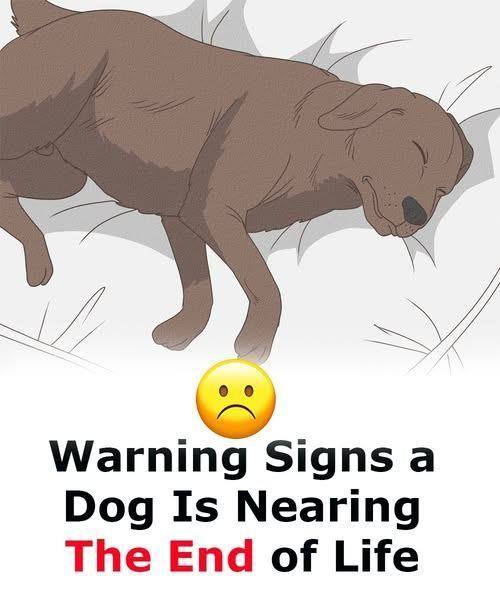As pet owners, we often think of our dogs as part of the family. Their loyalty, companionship, and joy brighten our lives every day, making it an incredibly difficult and emotional experience when we realize that our furry friend may be nearing the end of their life. While it’s a hard reality to face, understanding the warning signs that a dog is reaching the final stages of life can help us provide them with the best possible care, comfort, and love during their remaining time.

In this guide, we explore the common signs and symptoms that can indicate a dog is nearing the end of their life, as well as how to recognize when it’s time to say goodbye. Knowing these signs can help you make the right decisions to ensure your dog’s comfort and quality of life during this sensitive time.
1. Significant Decrease in Appetite or Difficulty Eating
One of the first signs that a dog may be nearing the end of their life is a marked decrease in appetite. While dogs may lose their appetite for a short period of time due to illness or stress, prolonged lack of interest in food is often a key indicator that something more serious is happening. This loss of appetite can result from a variety of conditions, such as organ failure, digestive issues, or severe pain. If your dog is refusing food or struggling to eat, it’s essential to monitor them closely and consult a veterinarian.
2. Extreme Fatigue and Weakness
If your dog is typically energetic and suddenly becomes lethargic or weak, this can be a sign that they are nearing the end of their life. Dogs may begin to sleep more than usual and struggle to get up or move around as easily. This fatigue is often due to the body’s organs beginning to shut down, a lack of energy, or pain from conditions such as arthritis, cancer, or heart disease. If you notice that your dog is no longer able to enjoy their favorite activities or seems to tire easily, it’s important to evaluate their overall health and consult a vet.
3. Incontinence or Difficulty with Mobility
As dogs age or approach the end of their life, they may experience a decline in their ability to control their bodily functions. This can include urinating or defecating in places they would normally avoid or losing control over their bladder and bowels. In addition to incontinence, many older dogs begin to struggle with mobility. They may have difficulty walking, standing up, or climbing stairs. These physical challenges often stem from conditions like arthritis, neurological disorders, or muscular degeneration, which can worsen as their body’s systems begin to fail.
4. Changes in Breathing Patterns
Changes in your dog’s breathing can be a significant indicator that they are nearing the end of their life. Labored or irregular breathing, as well as excessive panting or a lack of energy to take deep breaths, can signal that the dog’s body is not functioning properly. This could be a sign of respiratory failure, heart disease, or a variety of other conditions. If you notice that your dog is having trouble breathing, it is crucial to take them to the vet immediately for an evaluation.
5. Persistent Pain or Discomfort
Dogs who are nearing the end of their life may exhibit signs of pain or discomfort that can become increasingly difficult to manage. This pain may manifest as a reluctance to move, whimpering, or a change in behavior, such as becoming more withdrawn or irritable. If your dog is showing signs of persistent pain, it’s important to have a conversation with your veterinarian about pain management options. In some cases, medications or other therapies can help ease their suffering, allowing them to live their final days with more comfort.
6. Behavioral Changes or Disorientation
Another sign that a dog may be nearing the end of their life is noticeable changes in their behavior. Dogs may become confused or disoriented, exhibiting symptoms similar to dementia. This can include wandering aimlessly, getting stuck in corners or under furniture, or displaying signs of anxiety and restlessness. They may also show a decreased interest in interacting with their family members or engaging in normal activities. Behavioral changes can indicate cognitive decline, neurological issues, or pain from an underlying condition.
7. Severe Weight Loss or Dehydration
Significant weight loss and dehydration are common in dogs nearing the end of their life, particularly if they have an illness such as cancer, kidney disease, or liver failure. A decrease in appetite combined with excessive drinking or urination can contribute to dehydration, which can further weaken the body. If your dog is losing weight rapidly, it’s important to provide them with the proper care and hydration to help maintain their strength. Consult your veterinarian about possible ways to manage their nutrition and hydration levels during this time.
8. Unexplained Bleeding or Discharge
Unexplained bleeding or abnormal discharge is a serious sign that your dog’s health may be in decline. This can include coughing up blood, nosebleeds, blood in the urine, or vaginal discharge. These symptoms could indicate internal bleeding, organ failure, or a serious infection. If you notice any of these symptoms, it’s important to seek veterinary attention immediately to assess your dog’s condition and determine the best course of action.
9. Loss of Interest in Socialization or Affection
Dogs are naturally social animals, and many owners notice that their dogs may become less affectionate or withdraw from social interactions as they near the end of life. This could be due to physical discomfort, changes in cognitive function, or the dog’s natural instinct to withdraw as they prepare to pass. While some dogs may continue to seek comfort and affection from their owners, others may prefer solitude in their final days. If your dog is showing less interest in interacting with family members, it’s essential to respect their wishes while continuing to monitor their overall health.
10. End of Life Decision: When Is It Time?
One of the hardest decisions a pet owner may have to make is determining when it’s time to say goodbye. It’s never easy, and no one can make this decision for you, but there are some key factors to consider. If your dog is in constant pain, unable to eat or drink, and their quality of life has drastically diminished, it may be time to consider euthanasia to end their suffering peacefully. A conversation with your veterinarian can help you navigate this difficult decision and ensure that your dog’s final moments are as peaceful and comfortable as possible.
Conclusion: Honoring Your Dog’s Final Days
Recognizing the signs that a dog is nearing the end of their life is difficult, but it’s an essential part of being a compassionate pet owner. By understanding these symptoms and providing your dog with the care and comfort they need in their final days, you can ensure that their transition is as peaceful and loving as possible. Remember that it’s okay to seek help from your veterinarian, a pet hospice provider, or a support group to help you navigate this emotional journey. No matter how difficult, saying goodbye to a beloved pet is an act of love and compassion, and your dog will always hold a special place in your heart.
As pet owners, we owe it to our furry friends to give them the best care, right until the very end.

